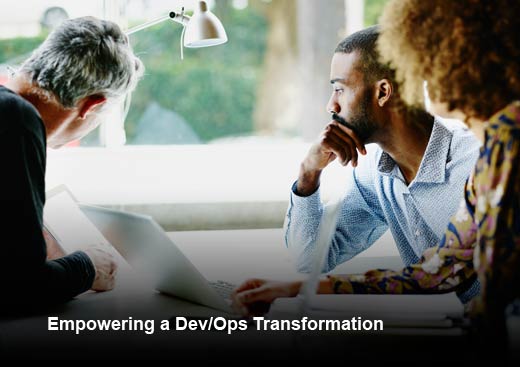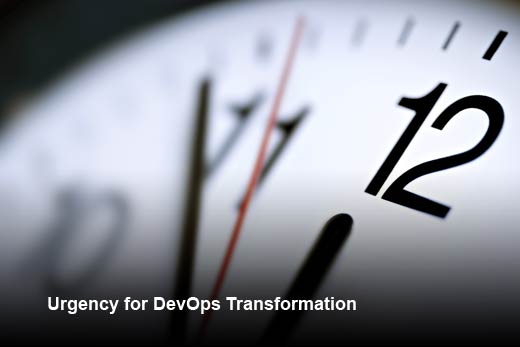DevOps is not a market nor a methodology, but rather a philosophy. A portmanteau of developers and operations, DevOps can be thought of as a cultural movement or practice emphasizing collaboration and communication between software developers and other IT professionals. The goal? To increase the speed, frequency and reliability of building, testing and releasing software.
Today, the adoption of DevOps is growing rapidly across many industries. DevOps boasts both technical and business benefits. These include continuous delivery, continuous integration, simplicity of problems, increases in both productivity and value and time saved. In order to fully understand DevOps, one must live its values. This requires an organizational overhaul for IT departments and the shift to a non-traditional approach. Trust must be given to those chosen to lead the change, but enterprises still need concrete ways to measure success. As with any business venture, creativity is a means to an end, but the return on investment (ROI) is invaluable.
Before continuous delivery can be achieved, one must first develop a vision and begin implementing successful DevOps practices. According to John Purrier, CTO of Automic, adopting the following seven steps will empower teams in their efforts toward a sustainable DevOps transformation.
Empowering a Dev/Ops Transformation
Click through for seven steps that will empower IT teams in their efforts toward a sustainable DevOps transformation, as identified by John Purrier, CTO of Automic.
Urgency for DevOps Transformation
An effective DevOps transformation will take time, so it is imperative to start as soon as possible. Your successful competitors have earned that reputation because their transformation has already happened. This sense of urgency must be passed down throughout the company.
The speed of a shift to DevOps is only measured by release velocity. Benchmarking against other companies is important in order to show progress, to give team members proof that their efforts are worthwhile, and to provide a quantifiable measurement.
A DevOps Team Vision
Team members that support change will form the backbone of your transformation. Senior IT management should be involved, but only if they have the right attitude. Those resisting change may have to step aside, no matter how skilled or experienced.
DevOps should be aligned with the business vision of continuous delivery. The scope should be wide enough to cover all aspects of the DevOps movement, but be narrowed to focus on continuous delivery when required. A roadmap is needed to document key aims and their chronological priority along the journey. This takes preference over a detailed plan, as agile principles should guide day-to-day decision making.
Communication Is Key
DevOps revolves around collaboration, so its inception in your IT department should be very much a team effort. A democratic atmosphere is key to the blurring of development and operations, so feedback and input are essential.
The vision and roadmap should be conferred quickly once decisions are made, in order to build trust and achieve visibility. The message should be communicated on repeat to engrain the new vision in the psyche of team members. Remember, after many decades working as software engineers, some team members will need outside encouragement to change no matter how willing they might be.
Empowerment
After communication comes the transfer of power and trust. It is important to allow DevOps team members to be autonomous when forging new collaborations and methods to reduce complexity and work efficiently.
Team Building
The end product of team building on a micro scale is to produce an overall guiding coalition. The ability to experiment with new tools and methods is vital, so the aim of the coalition is to remove obstacles such as superfluous process steps, approvals and system access rights. Any structures that undermine the team vision should be quickly replaced. Risk taking and avant-garde thinking should be encouraged.
Short-Term Wins
It’s important to deliver visible results to the business to prove ROI. Pilot projects using more established team members can be used to show the increase in release velocity.
A pilot team should be chosen carefully, depending on the application. A good fit in terms of technology and architecture is more important than simply choosing your most highly skilled staff members and fitting them around the project. The impact of DevOps practices should be exhibited to the business wherever possible.
Establish Change and Increase the Scale
Methodologies of experiments that worked well should be embedded into the culture for long-term success. This might mean changing long-standing practices across the board, so brave decision-making is needed. The credibility gained from pilot schemes can be used to prove the new system works in practice. However, each team should be allowed to practice their own flavor of the common methodology if it helps them work faster. Agility is key to increasing velocity, so governance frameworks should be avoided.
After a while, these brave new methodologies will become part of business as usual. To ensure the right path is being followed, the right metrics need to be in place with close links to business KPIs.










